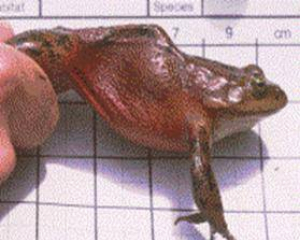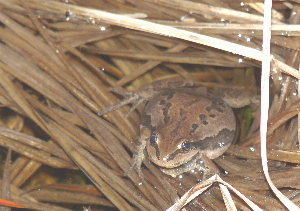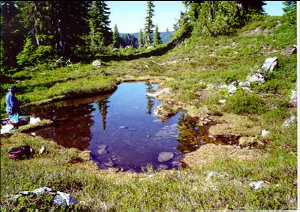Search ARMI Database
Search term(s)
Contribution Number
Search Results
856 record(s) found.
Papers & Reports Feeding behavior and aquatic habitat use by Oregon spotted frogs (Rana pretiosa) in central Oregon
Authors: Christopher A Pearl; Jay Bowerman; D Knight
Date: 2005 | Outlet: Northwestern Naturalist 86: 36-38
Papers & Reports Widespread occurrence of the chytrid fungus Batrachochytrium dendrobatidis on Oregon Spotted Frogs (Rana pretiosa)
Authors: Christopher A Pearl; Jay Bowerman; Michael J Adams; Nathan D Chelgren
Date: 2010 | Outlet: EcoHealth
The pathogen Batrachochytrium dendrobatidis (Bd) has been associated with amphibian declines in multiple continents, including western North America. We investigated Bd prevalence in Oregon spotted frog (Rana pretiosa), a species that has declined across its range in the Pacific Northwest. Polymerase Chain Reaction analysis of skin swabs indicated that Bd was prevalent within populations (420 of 617 juvenile and adults) and widespread among populations (36 of 36 sites) where we sampled R. pretiosa in Oregon and Washington. We rarely detected Bd in R. pretiosa larvae (2 of 72). Prevalence of Bd in post-metamorphic R. pretiosa was inversely related to frog size. We found support for an interactive effect of elevation and sampling date on Bd: prevalence of Bd generally increased with date but this effect was more pronounced at lower elevations. We also found evidence that the body condition of juvenile R. pretiosa with Bd decreased after their first winter. Our data indicate that some Oregon spotted frog populations are currently persisting with relatively high Bd prevalence, but the risk posed by Bd is unknown.
Papers & Reports Observations of rapid colonization of constructed ponds by western toads (Bufo boreas) in Oregon, USA
Authors: Christopher A Pearl; Jay Bowerman
Date: 2006 | Outlet: Western North American Naturalist 66: 397-401
Papers & Reports Characteristics of Columbia spotted frog (Rana luteiventris) oviposition sites in northeastern Oregon
Authors: Christopher A Pearl; Michael J Adams; W H Wente
Date: 2007-01 | Outlet: Western North American Naturalist 67: 86-91
Several western ranid frogs possess a unique strategy of breeding communally over a short temporal window and reusing oviposition sites between years. However, little is published on the characteristics of oviposition sites selected by these explosive breeders. The Columbia spotted frog (Rana luteiventris) is native to northwestern North America and is of conservation concern in the southern portions of its range. As part of a study examining relationships between livestock grazing and R. luteiventris habitat, we assessed characteristics of the species’ oviposition sites in 25 fishless ponds in northeastern Oregon. Oviposition sites were generally in shallow water (25 cm) close to shore and tended to be in the northeastern portion of ponds. Oviposition sites were found more frequently over heavily vegetated substrates and in areas of less substrate slope and shade than random points in littoral zones. We did not quantify temperature differences within ponds but the patterns we documented are consistent with preferential use of warmer microhabitats for oviposition.
Papers & Reports Behavioral responses of anuran larvae to chemical cues of native and introduced predators in the Pacific Northwestern United States
Authors: Christopher A Pearl; Michael J Adams; G S Schuytema; A V Nebeker
Date: 2003-09-01 | Outlet: Journal of Herpetology 37: 572-576
We compared behavioral responses of three Pacific Northwest anuran larvae from different hydroperiods to water born cues of native and introduced predators. Two native anurans (Pacific treefrog, Pseudacris regilla and northern red-legged frog, Rana aurora aurora) and introduced bullfrogs (Rana catesbeiana) responded to water conditioned by native redside shiners (Richardsonius balteatus) by increasing refuge use. The two native anuran larvae differed in their response to introduced predator cues. Rana a. aurora, which occur in temporary and permanent waters, responded to both introduced bluegill sunfish (Lepomis macrochirus) and introduced crayfish (Procambarus clarkii). Pseudacris regilla, which occur primarily in temporary ponds, did not respond to water born cues from either introduced predator. The broader responses of R. a. aurora may indicate greater behavioral plasticity or more exposure to novel predators than experienced by P. regilla. Larvae of introduced R. catesbeiana responded strongly to cues from two fish native to the Pacific northwest, but did not alter behavior in response to any of five potential predators with which they co-occur in their native range. Fish that occur with R. catesbeiana in their native range generally find bullfrog tadpoles unpalatable. This pattern suggests that bullfrog larvae can recognize cues of novel predators that may find them palatable, which could contribute to their success as an invasive species in the region.
Papers & Reports Breeding habitat and local population size of the Oregon spotted frog (Rana pretiosa) in Oregon, USA
Authors: Christopher A Pearl; Michael J Adams; N Leuthold
Date: 2010 | Outlet: Northwestern Naturalist 91
The distribution of the Oregon Spotted Frog (Rana pretiosa) has shrunk markedly and more than 2/3 of known populations are located along the Cascade Range in central Oregon. Despite the conservation concern, little is known about how habitat attributes and stressors such as invasive species influence R. pretiosa populations. We used egg mass counts to study R. pretiosa habitat relationships at oviposition sites and breeding ponds. Oviposition sites were in shallow water above gradually sloping substrates that supported moderate or dense herbaceous vegetation. Sixty-one per cent of occupied breeding ponds had fewer than 20 egg masses. We found strong support for two predictors of egg mass count: positive effect of other R. pretiosa breeding sites nearby and a negative effect of non-native fish having access to preferred R. pretiosa overwintering habitat. We found moderate support for effects of emergent and submergent vegetation coverage (positive) and of ponds being located in the Klamath Basin (negative). Maintaining and restoring overwintering habitats that are free of non-native game fish is likely to benefit R. pretiosa. Further work on movement ecology is needed to improve our understanding of habitat connectivity and the effects of site isolation on the persistence of R. pretiosa in Oregon.
Papers & Reports Asymmetrical effects of non-native bullfrogs (Rana catesbeiana) on native ranid frogs in Oregon, USA
Authors: Christopher A Pearl; Michael J Adams; Richard B Bury; Brome McCreary
Date: 2004-02-01 | Outlet: Copeia 2004: 11-20
Introduced American bullfrogs (Rana catesbeiana) have become widely established in the Pacific Northwest over the last century, and are thought to be an important predator of native amphibians throughout the western USA. The northern red-legged frog (Rana aurora aurora) and Oregon spotted frog (Rana pretiosa) historically co-occurred in portions of the Pacific Northwest now invaded by R. catesbeiana, but R. pretiosa has declined more severely than R. a. aurora. We investigated whether microhabitat and behavioral differences that facilitate sympatric coexistence of the natives predict which species is more susceptible to predation by introduced R. catesbeiana. Our laboratory experiments demonstrate that R. catesbeiana adults prefer aquatic microhabitats, R. pretiosa juveniles are more aquatic than R. a. aurora, and that adult R. catesbeiana consume more R. pretiosa than R. a. aurora juveniles. Mean and maximum jump distances of R. pretiosa were shorter than equally-sized R. a. aurora, and the difference between these two species increased with larger frog sizes. Our examination of field survey data indicates that R. pretiosa co-occur with R. catesbeiana less frequently than R. a. aurora. We conclude that R. catesbeiana is a greater threat to survival of R. pretiosa than to R. a. aurora, and suggest that microhabitat use and escape abilities of native ranid frogs may be linked to this asymmetrical effect. Analysis of behavioral and microhabitat differences among related native species may be a useful tool in predicting the effects of introduced predators on amphibians, and can assist in developing conservation priorities for these species.
Papers & Reports Amphibian occurrence and aquatic invaders in a changing landscape: implications for wetland mitigation in the Willamette Valley, Oregon
Authors: Christopher A Pearl; Michael J Adams; Richard B Bury; N Leuthold
Date: 2005-03-01 | Outlet: Wetlands 25: 76-88
Despite concern about the conservation status of amphibians in western North America, few field studies have documented occurrence patterns of amphibians relative to potential stressors. We surveyed wetland fauna in Oregon’s Willamette Valley and used an information theoretic approach (AIC) to rank the associations between native amphibian breeding occurrence and wetland characteristics, non-native aquatic predators, and landscape characteristics in a mixed urban-agricultural landscape. Best predictors varied among the 5 native amphibians, and were generally consistent with life history differences. Pacific tree frog (Pseudacris regilla) and long-toed salamander (Ambystoma macrodactylum) occurrence was best predicted by the absence of non-native fish. Northern red-legged frog (Rana aurora) and northwestern salamander (Ambystoma gracile) were most strongly related to wetland vegetative characteristics. The occurrence of rough-skinned newts (Taricha granulosa), a migratory species that makes extensive use of terrestrial habitats, was best predicted by greater forest cover within 1 km. The absence of non-native fish was a strong predictor of occurrence for 4 of the 5 native species. In contrast, amphibians were not strongly related to native fish presence. We found little evidence supporting negative effects of the presence of breeding populations of bullfrog (Rana catesbeiana) on any native species. Only the 2 Ambystoma salamanders were associated with wetland permanence. Northwestern salamanders (which usually have a multi-year larval stage) were associated with permanent waters, while long-toed salamanders were associated with temporary wetlands. Although all the species make some use of upland habitats, only one (rough-skinned newt) was strongly associated with surrounding landscape conditions. Instead, our analysis suggests within wetland characteristics best predict amphibian occurrence in this region. We recommend that wetland preservation and mitigation efforts concentrate on sites lacking non-native fish for the conservation of native amphibians in the Willamette Valley and other western lowlands.
Papers & Reports Rana cascadae Slater, 1939, Cascade Frog
Authors: Christopher A Pearl; Michael J Adams
Date: 2005 | Outlet: Lannoo M, editor. Amphibian declines: the conservation status of United States species. Berkeley: University of California Press Pp 538-540
A species account for Rana cascadae.
Papers & Reports Taricha granulosa (Rough skin newt). Summer habitat and aggregation
Authors: Christopher A Pearl
Date: 2006 | Outlet: Herpetological Review 37: 71-72
Papers & Reports Rana aurora (Baird and Girard, 1852[b]), Northern red-legged frog
Authors: Christopher A Pearl
Date: 2005 | Outlet: Lannoo M, editor. Amphibian declines: the conservation status of United States species. Berkeley: University of California Press Pp 528-530
Papers & Reports Amphibian decline in Yellowstone National Park
Authors: Debra A Patla; Charles R Peterson; P. Stephen Corn
Date: 2009 | Outlet: Proceedings of the National Academy of Sciences, USA 106(9): E22
As researchers engaged in long-term amphibian monitoring in Yellowstone National Park (YNP), we read the paper by McMenamin et al. with interest. This study documents a decline in the extent of seasonal wetlands in the Lamar Valley of YNP during an extended drought, but their conclusion, widely reported in the media, of “severe declines in 4 once-common amphibian species”, is unsupported. Their analysis incorrectly defines populations, ignores significant inter-annual variation in amphibian occurrence, and is applicable to only a tiny fraction of YNP.
Papers & Reports Amphibian diversity, distribution, and habitat use in the Yellowstone Lake basin
Authors: Debra A Patla; Charles R Peterson
Date: 2002 | Outlet: Proceedings of the Sixth Biennial Scientific Conference on the Greater Yellowstone Ecosystem, October 8–10, 2001, Mammoth, Yellowstone National Park
Global amphibian population declines are being investigated through four interdependent fields of study: distribution and status, ecology, causes of declines, and environmental contexts. In Yellowstone National Park, work on amphibians has proceeded in all four of these fields. This paper describes amphibian species occurrence, distribution, and habitat-use patterns in the Yellowstone Lake area; summarizes the findings of a field study on habitat use by spotted frogs; and describes the directions and goals of continued amphibian investigations. Tiger salamanders, western toads, boreal chorus frogs, and Columbia spotted frogs all occur in the subwatersheds surrounding Yellowstone Lake. Chorus frogs and spotted frogs are the most common species. Salamanders are uncommon. Toads are rare, and we are concerned about their status in Yellowstone and in the Greater Yellowstone Ecosystem. A large variety of wetlands in the Yellowstone Lake basin provide breeding sites. Foraging and overwintering sites are also crucial to amphibian persistence. A case study of spotted frogs in the Lake Lodge area exemplifies this and underscores the need to understand habitat requirements, movement capabilities, and the effects of human activities. Amphibian investigations in Yellowstone over the next several years will probably focus on completing distribution surveys for inventory and monitoring purposes, research into habitat use and amphibian movements, and habitat mapping and modeling. The practical goal is an integrated information system that Yellowstone National Park can use for environmental analysis, project planning, monitoring, research, evaluation of ecosystem health, and education.
Papers & Reports Amphibian monitoring in the Greater Yellowstone Network—project report 2007: Grand Teton and Yellowstone National Parks
Authors: Debra A Patla; W R Gould
Date: 2008 | Outlet: Natural Resource Report NPS/GRYN/NRR—2008/00x. Ft. Collins, CO: National Park Service
Papers & Reports Protecting amphibian populations while restoring fish populations
Authors: Debra A Patla
Date: 2005 | Outlet: Lannoo M, editor. Amphibian declines: the conservation status of United States species. Berkeley: University of California Press 275–276
In Yellowstone National Park, four species of non-native trout were introduced. have become established, and threaten the survival of indigenous fish. A program to remove non-native trout has begun, but techniques used to remove these fish also threaten amphibians. Recommendations are made to eliminate or reduce the threat to amphibians, including making managers aware of the presence of amphibians, and offering strategies for reducing amphibian vulnerability to fish removal techniques.
Papers & Reports A field guide to amphibian larvae and eggs of Minnesota, Wisconsin, and Iowa
Authors: J R Parmalee; M Knutson; J E Lyon
Date: 2002 | Outlet: U.S. Geological Survey Information and Technology Report USGS/BRD/ITR-2002-0004 38
Papers & Reports Optical characteristics of natural waters protect amphibians from UV-B in the US Pacific Northwest: reply
Authors: Wendy J Palen; D E Schindler; Michael J Adams; Christopher A Pearl; Richard B Bury; S Diamond
Date: 2004-06-01 | Outlet: Ecology 85: 1754-1759
Few ecologists would dispute that exposure to high levels of ultraviolet-B radiation (UV-B) is detrimental to organisms. It is well established that UV-B has been a critical factor shaping the physiology (Blum et al. 1949, Hansson 2000), behavior (Pennington and Emlet 1986, van de Mortel and Buttemer 1998), and distribution (Williamson et al. 2001, Leavitt et al. 2003) of many aquatic species. Recently, increasing UV-B caused by stratospheric ozone depletion has stimulated much research on the UV-B sensitivity of a wide variety of taxa, and has been found to cause direct mortality (Calkins and Thordardottir 1980, reviewed by Siebeck et al. 1994), elevate developmental abnormalities (Ankley et al. 2002), increase susceptibility to disease (Little and Fabacher 1994, Kiesecker and Blaustein 1995), and change the strength of species interactions (Sommaruga 2003). Increasing levels of UV-B have also been invoked as an explanation for the decline of some amphibian species, and support for this hypothesis has been extrapolated from many laboratory experiments and field studies at individual sites that indicate ambient or enhanced levels of UV-B can increase mortality of embryos and larvae (but see Licht 2003). This has been an especially attractive hypothesis for amphibian populations in alpine environments where direct anthropogenic impacts such as habitat modification are limited and ambient levels of UV-B are high (Blaustein and Wake 1990, Blaustein et al. 1994, Alford and Richards 1999). However, for all the attention UV-B has received in the context of declining amphibian populations, there is little evidence linking the physiological sensitivity of individuals to actual population dynamics (Licht 2003).
Papers & Reports Optical characteristics of natural waters can protect amphibian populations from UV-B in the US Pacific Northwest
Authors: Wendy J Palen; D E Schindler; Michael J Adams; Christopher A Pearl; Richard B Bury; S Diamond
Date: 2002 | Outlet: Ecology 83: 2951-2957
Increased exposure to ultraviolet-B (UV-B) radiation has been proposed as a major environmental stressor leading to global amphibian declines. Prior experimental evidence from the US Pacific Northwest (PNW) has established the embryonic sensitivity of at least 4 amphibian species to UV-B and has been central to the amphibian decline literature. However, these results have not been expanded to address population-scale effects and natural landscape variation in UV-B transparency of water at amphibian breeding sites; necessary links to assess the importance of UV-B for amphibian declines. We quantified the UV-B transparency of 136 potential amphibian breeding sites to establish the pattern of UV-B exposure across two montane regions in the PNW. Our data suggest that 85% of sites are naturally protected by dissolved organic matter (DOM) in pond water, and that only a fraction of breeding sites are likely to experience UV-B intensities exceeding levels associated with elevated egg mortality. Thus, the spectral characteristics of natural waters mediate the physiological effects of UV-B on amphibian eggs in all but the clearest sites. These data imply that UV-B is unlikely to cause broad amphibian declines across the landscape of the American Northwest.
Papers & Reports Bufo baxteri Porter, 1968, Wyoming toad
Authors: R A Odum; P. Stephen Corn
Date: 2005 | Outlet: Lannoo M, editor. Amphibian declines: the conservation status of United States species. Berkeley: University of California Press 390–392
Species account of the Endangered Wyoming Toad.
Papers & Reports Estimating site occupancy and detection probability parameters for mammals in a coastal ecosystem.
Authors: A F O'Connell; N W Talancy; Larissa L Bailey; J R Sauer; R Cook; A T Gilbert
Date: 2007 | Outlet: Journal of Wildlife Management 70: 1625-1633








